
Papilio is a genus in the swallowtail butterfly family, Papilionidae, as well as the only representative of the tribe Papilionini. The word papilio is Latin for butterfly.

Swallowtail butterflies are large, colorful butterflies in the family Papilionidae, and include over 550 species. Though the majority are tropical, members of the family inhabit every continent except Antarctica. The family includes the largest butterflies in the world, the birdwing butterflies of the genus Ornithoptera.
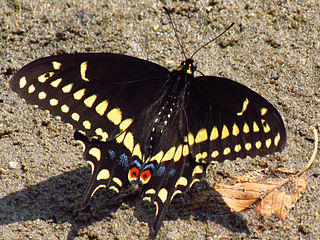
Papilio polyxenes, the (eastern) black swallowtail, American swallowtail or parsnip swallowtail, is a butterfly found throughout much of North America. It is the state butterfly of Oklahoma and New Jersey. An extremely similar-appearing species, Papilio joanae, occurs in the Ozark Mountains region, but it appears to be closely related to Papilio machaon, rather than P. polyxenes. The species is named after the figure in Greek mythology, Polyxena, who was the youngest daughter of King Priam of Troy. Its caterpillar is called the parsley worm because the caterpillar feeds on parsley.

The scarce swallowtail is a butterfly belonging to the family Papilionidae. It is also called the sail swallowtail or pear-tree swallowtail.

Papilio machaon, the Old World swallowtail, is a butterfly of the family Papilionidae. The butterfly is also known as the common yellow swallowtail or simply the swallowtail. It is the type species of the genus Papilio. This widespread species is found in much of the Palearctic and in North America.
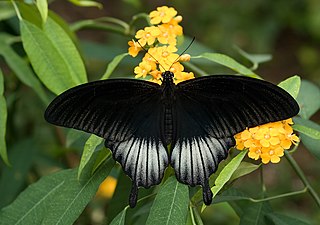
Papilio memnon, the great Mormon, is a large butterfly native to southern Asia that belongs to the swallowtail family. It is widely distributed and has thirteen subspecies. The female is polymorphic and with mimetic forms.

Teinopalpus imperialis, the Kaiser-i-Hind, is a rare species of swallowtail butterfly found from Nepal and north India east to north Vietnam. The common name literally means "emperor of India". The Kaiser-i-Hind is much sought after by butterfly collectors for its beauty and rarity. The green iridescence of the wings has been found to be due to three-dimensional photonic structure of the scales and is the subject of much research.

Papilio (Chilasa) agestor, the tawny mime, is a swallowtail butterfly, native to Indian subcontinent and widely found across Asia. The butterfly belongs to the mime subgenus, Chilasa, of the genus Papilio or the black-bodied swallowtails.

Papilio hospiton, the Corsican swallowtail, is a species of butterfly in the family Papilionidae. It is found only in Corsica and Sardinia in the Mediterranean Sea.

The Oregon swallowtail is a subspecies of swallowtail butterfly native to the United States of America, Oregon, Washington, and Idaho and south-central British Columbia in Canada. In 1976, it became one of the first four butterflies that the United States Postal Service placed on a U.S. stamp.
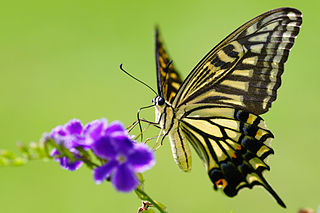
Papilio xuthus, the Asian swallowtail, Chinese yellow swallowtail or Xuthus swallowtail, is a yellow-colored, medium to large sized swallowtail butterfly found in northeast Asia, northern Myanmar, southern China, Taiwan, the Korean Peninsula, Japan, Siberia and the Hawaiian Islands. It was also recorded in the state of Arunachal Pradesh, India, in 2014.

Cressida cressida, the clearwing swallowtail or big greasy, is a Troidine swallowtail butterfly found in northern Australia, New Guinea, Maluku, and Timor. It is in the monotypic genus Cressida.

Chazara briseis, the hermit, is a butterfly species belonging to the family Nymphalidae. It can be found in North Africa, southern Europe, Asia Minor, the Caucasus, Kazakhstan, Central Asia through Afghanistan, and north-western China and Tuva. It is found on steppe and in other dry grassy places between 500 and 2,500 meters.
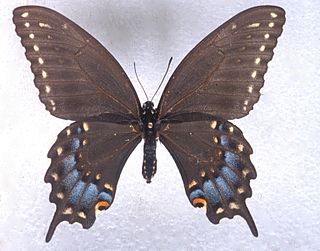
Papilio joanae, the Ozark swallowtail, is a North American butterfly species in the family Papilionidae. It was once considered a synonym of the black swallowtail.

Polyommatus thersites, the Chapman's blue, is a butterfly in the family Lycaenidae. It is found in southern Europe, Morocco, Lebanon, Asia Minor, Iran and across the Palearctic to Siberia and Tian Shan.
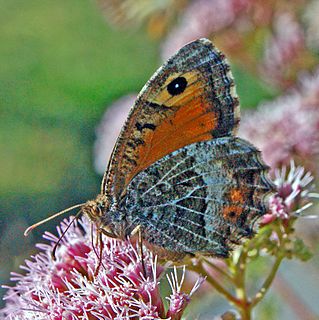
Arethusana is a butterfly genus from the subfamily Satyrinae of the brush-footed butterfly family (Nymphalidae). It is composed of only one species, Arethusana arethusa, the false grayling.

Polyommatus damone is a butterfly found in the Palearctic that belongs to the blues family.



















